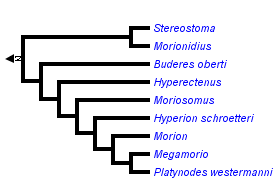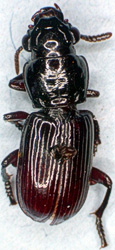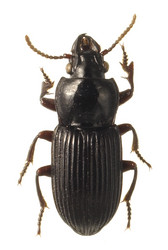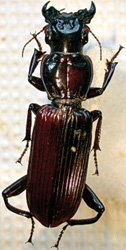Morionini
Kipling Will


This tree diagram shows the relationships between several groups of organisms.
The root of the current tree connects the organisms featured in this tree to their containing group and the rest of the Tree of Life. The basal branching point in the tree represents the ancestor of the other groups in the tree. This ancestor diversified over time into several descendent subgroups, which are represented as internal nodes and terminal taxa to the right.

You can click on the root to travel down the Tree of Life all the way to the root of all Life, and you can click on the names of descendent subgroups to travel up the Tree of Life all the way to individual species.
For more information on ToL tree formatting, please see Interpreting the Tree or Classification. To learn more about phylogenetic trees, please visit our Phylogenetic Biology pages.
close boxIntroduction
Presently there are 87 named species in the tribe, the majority (69) in Morion Latreille and Stereostoma Murray. Most species are found in tropical or subtropical regions with a few taxa reaching low latitude temperate areas.
Characteristics
The combination of moniliform antennomeres, prominent eyes (except in Hyperectenus Alluaud), elytral plica not externally visible, expanded apex of the protibia with an apico-laterally produced spine (except in Morionidius Chaudoir) and projecting dentiform process above the insertion point of the antenna is characteristic of members of this tribe.
All species in the tribe are deep black to piceus brown, rather shiny and typically large sized, most about 15-30mm (range 8-80mm). Most species are Morion-like in general form, elongate, parallel-sided and somewhat depressed and subpedunculate. However, many of the genera, which contain about a third of the species, are much more compact and convex in form. All have deeply impressed frontal impressions on the head and deep, linear pronotal basal impressions.
Allen (1968) presented five features he considered to characterize the tribe: moniliform antennae, elytral plica internal, 4-12 setae on lateral margin of the pronotum, stria 8 with alternating setigerous punctures and the rod-like process of the endophallus. Many taxa do have these features, however, aside from the moniliform antennae, none of these characters is found to be definitive for the tribe as a whole. Most of these are known only in the more derived Morion-like genera and exceptions are common, e.g., Hyperion Laporte de Castelnau lacks pronotal setae, Buderes Murray and Hyperectenus lack the additional setigerous punctures of stria 8 and Stereostoma does not have the process of the endophallus.
Discussion of Phylogenetic Relationships
Monophyly for the tribe is supported by a single synapomorphy, moniliform antennomeres, a characteristic found in several other groups of Carabidae, and in Hyperion the antennae are submoniliform. Other characters of the eyes and head, under specific optimization hypotheses may support the monophyly of Morionini. Overall there is little support for a monophyletic Morionini including Stereostoma and Morionidius.
Information on the Internet
- Key to the Genera of Morionini - Kipling Will, UC Berkeley
- Phylogeny, characters and other information for the Genera of Morionini - Kipling Will, UC Berkeley
Title Illustrations

| Scientific Name | Morionidius doriae |
|---|---|
| Specimen Condition | Dead Specimen |
| Life Cycle Stage | Adult |
| View | Dorsal |
| Image Use |
 This media file is licensed under the Creative Commons Attribution License - Version 3.0. This media file is licensed under the Creative Commons Attribution License - Version 3.0.
|
| Copyright |
© 2005 Kipling Will

|
| Scientific Name | Moriosomus sylvestris |
|---|---|
| Acknowledgements | Image taken by Warren Steiner |
| Specimen Condition | Dead Specimen |
| Image Use |
 This media file is licensed under the Creative Commons Attribution-NonCommercial-ShareAlike License - Version 3.0. This media file is licensed under the Creative Commons Attribution-NonCommercial-ShareAlike License - Version 3.0.
|
| Copyright |
© Wendy Moore

|
| Scientific Name | Hyperion schroetteri |
|---|---|
| Location | Australia |
| Specimen Condition | Dead Specimen |
| Life Cycle Stage | Adult |
| View | Dorsal |
| Image Use |
 This media file is licensed under the Creative Commons Attribution License - Version 3.0. This media file is licensed under the Creative Commons Attribution License - Version 3.0.
|
| Copyright |
© 2005 Kipling Will

|
| Scientific Name | Platynodes westermanni |
|---|---|
| Location | Africa |
| Specimen Condition | Dead Specimen |
| Life Cycle Stage | Adult |
| View | Dorsal |
| Image Use |
 This media file is licensed under the Creative Commons Attribution License - Version 3.0. This media file is licensed under the Creative Commons Attribution License - Version 3.0.
|
| Copyright |
© 2005 Kipling Will

|
About This Page
Kipling Will

University of California, Berkeley, California, USA
Correspondence regarding this page should be directed to Kipling Will at
Page copyright © 2005 Kipling Will
 Page: Tree of Life
Morionini.
Authored by
Kipling Will.
The TEXT of this page is licensed under the
Creative Commons Attribution License - Version 3.0. Note that images and other media
featured on this page are each governed by their own license, and they may or may not be available
for reuse. Click on an image or a media link to access the media data window, which provides the
relevant licensing information. For the general terms and conditions of ToL material reuse and
redistribution, please see the Tree of Life Copyright
Policies.
Page: Tree of Life
Morionini.
Authored by
Kipling Will.
The TEXT of this page is licensed under the
Creative Commons Attribution License - Version 3.0. Note that images and other media
featured on this page are each governed by their own license, and they may or may not be available
for reuse. Click on an image or a media link to access the media data window, which provides the
relevant licensing information. For the general terms and conditions of ToL material reuse and
redistribution, please see the Tree of Life Copyright
Policies.
- Content changed 07 July 2006
Citing this page:
Will, Kipling. 2006. Morionini. Version 07 July 2006. http://tolweb.org/Morionini/103/2006.07.07 in The Tree of Life Web Project, http://tolweb.org/














 Go to quick links
Go to quick search
Go to navigation for this section of the ToL site
Go to detailed links for the ToL site
Go to quick links
Go to quick search
Go to navigation for this section of the ToL site
Go to detailed links for the ToL site